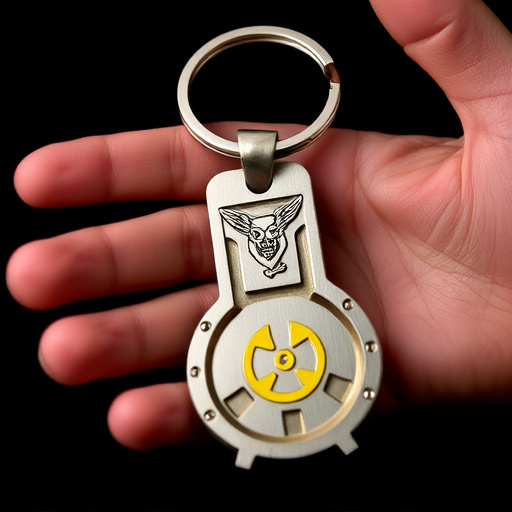Carrying a pocket-sized keychain defense weapon (PSKDW) in the U.S. requires understanding and adhering to varying state and local regulations. Research specific guidelines carefully, prioritize weight, size, material quality, multi-functionality, and reliable locking systems when choosing one. Responsible ownership involves thorough training, adherence to safety protocols, and deployment only as a last resort against imminent threats, balancing compactness with strength and versatility for peace of mind in potentially dangerous situations while minimizing public safety risks and legal consequences.
“In today’s unpredictable world, many individuals are seeking effective personal defense options that fit seamlessly into their daily lives. The pocket-sized keychain defense weapon has emerged as a popular choice for those prioritizing safety on the go. However, navigating the complex web of state laws regarding these compact self-defense tools can be daunting. This article guides you through the essential aspects of legal carry guidelines, ensuring you stay informed and prepared.”
- Understanding State Laws on Defensive Keychain Weapons
- What Constitutes a Legal and Safe Carry of a Keychain Defense Weapon?
- Key Considerations for Choosing the Right Pocket-Sized Self-Defense Tool
- Navigating Potential Challenges and Misconceptions About Legal Carry Guidelines
Understanding State Laws on Defensive Keychain Weapons
In the United States, the legal carry of defensive keychain weapons, also known as pocket-sized keychain defense tools or personal protection keychains, varies significantly from state to state. Understanding these laws is crucial for anyone considering carrying such a device for self-defense. Each state has its own set of regulations and restrictions on what constitutes a legal defensive weapon, including size, functionality, and permitted places of carry.
For example, some states explicitly allow certain types of keychain defense tools as long as they meet specific criteria, like being non-lethal and designed primarily for self-defense. Other states might have more stringent requirements, such as requiring permits or licensing for carrying any kind of personal defense tool. It’s also important to note that even within a state, local laws can further restrict the carry of these devices. Therefore, individuals looking to legally carry a pocket-sized keychain defense weapon must familiarize themselves with both state and local regulations to ensure compliance.
What Constitutes a Legal and Safe Carry of a Keychain Defense Weapon?
Carrying a keychain defense weapon, also known as a pocket-sized keychain self-defense tool, legally and safely requires understanding specific guidelines. What constitutes a legal carry largely depends on local and state regulations, which vary significantly across different jurisdictions. It’s crucial to research and comply with these laws to ensure you’re within the parameters set by your region.
A safe carry involves more than just adhering to the law; it also means practicing responsible handling and awareness. This includes keeping the device secured when not in use, ensuring it remains easily accessible for legitimate defense purposes only, and being familiar with its operation. Safe carry practices promote confidence and minimize accidental deployment or misuse, enhancing overall safety in potentially threatening situations.
Key Considerations for Choosing the Right Pocket-Sized Self-Defense Tool
When selecting a pocket-sized keychain defense weapon, there are several key considerations to keep in mind. Firstly, weight and size are crucial factors; the tool should be light enough to carry discreetly but robust enough to serve its purpose effectively. Look for options that fit comfortably in your palm, allowing for quick access without drawing undue attention. Secondly, material quality is essential for durability and safety. Opt for high-quality metals like stainless steel or aluminum alloys that can withstand regular use and impact.
Additional features also play a role in making the right choice. Consider tools with multiple functions, such as glass-breaking capabilities or sharp blades, which can enhance your defenses in various situations. Ensure the mechanism is easy to operate, even under stress, and prioritize products with reliable locking systems to prevent accidental deployment. Remember that the best pocket-sized keychain defense weapon balances compactness, strength, and versatility to provide peace of mind in potentially dangerous scenarios.
Navigating Potential Challenges and Misconceptions About Legal Carry Guidelines
Navigating Potential Challenges and Misconceptions About Legal Carry Guidelines
One of the primary challenges individuals face when considering legal carry guidelines for pocket-sized keychain defense weapons is dispelling misconceptions. Many people believe that carrying a small, concealable weapon makes them immediately perceived as dangerous or aggressive. However, responsible users understand that these tools are designed for personal safety and self-defense in unexpected situations. It’s crucial to emphasize that legal carry guidelines vary widely by state, and what’s permitted in one place might not be in another. Staying informed about local laws and adhering to them strictly is essential to avoid legal repercussions.
Another common challenge is the fear of overreaction or misuse. While it’s true that any weapon carries the potential for harm if used improperly, responsible ownership includes thorough training, understanding of safety protocols, and a commitment to only deploy such devices as a last resort when facing an imminent threat. Pocket-sized keychain defense weapons, due to their compact size, are often seen as more accessible options for self-defense. However, this accessibility also underscores the need for prudent use and respect for legal carry guidelines to ensure safety for all individuals involved.
In conclusion, navigating the legal landscape surrounding pocket-sized keychain defense weapons requires a thorough understanding of state guidelines. By grasping what constitutes safe and legal carry, considering key factors in tool selection, and addressing common misconceptions, individuals can ensure they remain within the law while protecting themselves. Remember, staying informed is crucial for responsible self-defense, enabling folks to make informed decisions about their safety without compromising legality.
